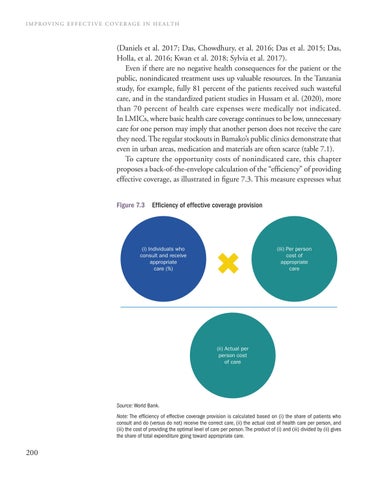IMPROVING EFFECTIVE COVERAGE IN HEALTH
(Daniels et al. 2017; Das, Chowdhury, et al. 2016; Das et al. 2015; Das, Holla, et al. 2016; Kwan et al. 2018; Sylvia et al. 2017). Even if there are no negative health consequences for the patient or the public, nonindicated treatment uses up valuable resources. In the Tanzania study, for example, fully 81 percent of the patients received such wasteful care, and in the standardized patient studies in Hussam et al. (2020), more than 70 percent of health care expenses were medically not indicated. In LMICs, where basic health care coverage continues to be low, unnecessary care for one person may imply that another person does not receive the care they need. The regular stockouts in Bamako’s public clinics demonstrate that even in urban areas, medication and materials are often scarce (table 7.1). To capture the opportunity costs of nonindicated care, this chapter proposes a back-of-the-envelope calculation of the “efficiency” of providing effective coverage, as illustrated in figure 7.3. This measure expresses what Figure 7.3
Efficiency of effective coverage provision
(i) Individuals who consult and receive appropriate care (%)
(iii) Per person cost of appropriate care
(ii) Actual per person cost of care
Source: World Bank. Note: The efficiency of effective coverage provision is calculated based on (i) the share of patients who consult and do (versus do not) receive the correct care, (ii) the actual cost of health care per person, and (iii) the cost of providing the optimal level of care per person. The product of (i) and (iii) divided by (ii) gives the share of total expenditure going toward appropriate care.
200

